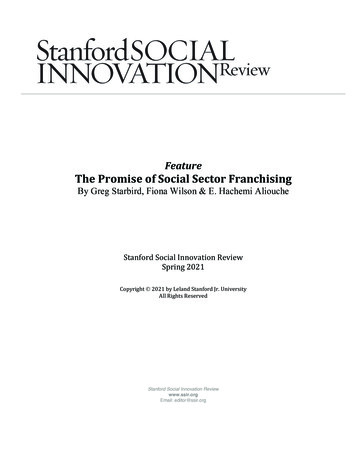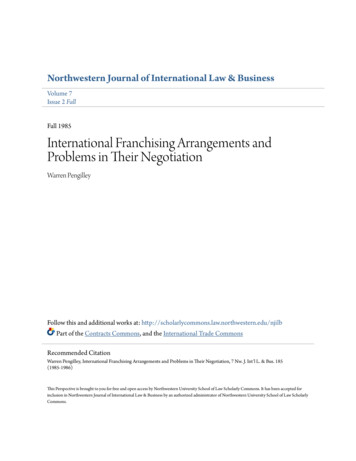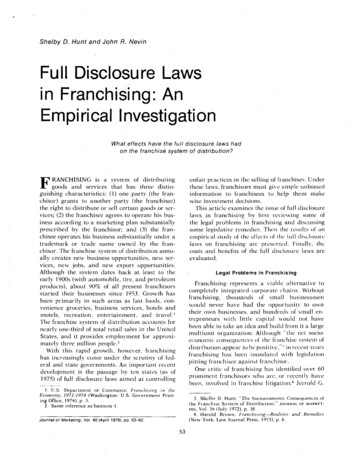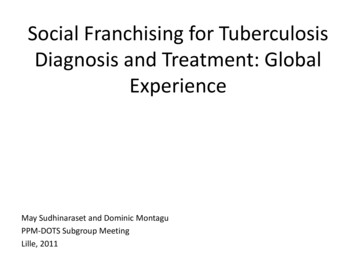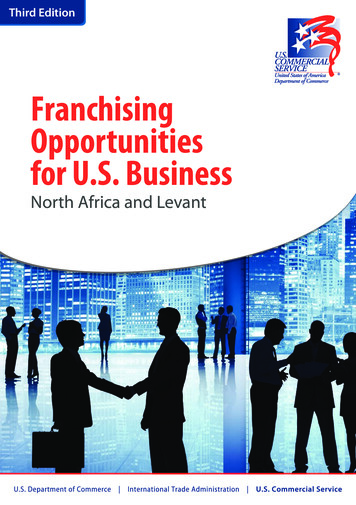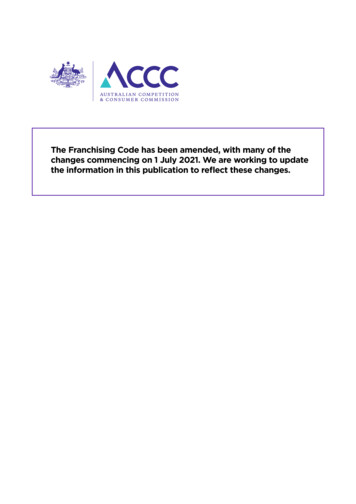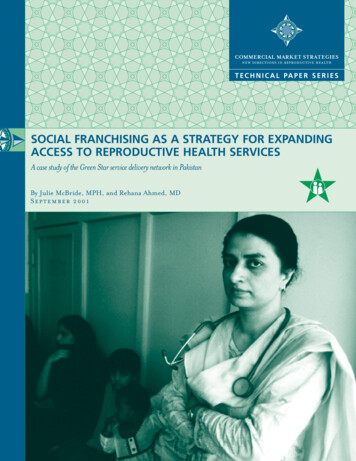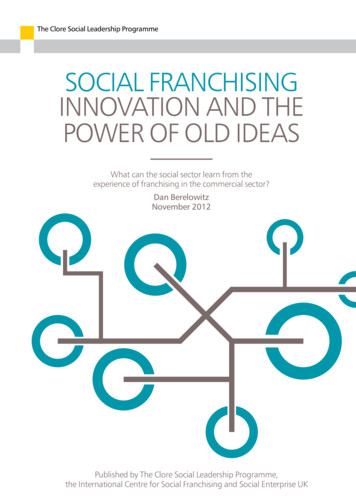
Transcription
The Clore Social Leadership ProgrammeSocial FranchisingInnovation and thepower of old ideasWhat can the social sector learn from theexperience of franchising in the commercial sector?Dan BerelowitzNovember 2012Published by The Clore Social Leadership Programme,the International Centre for Social Franchising and Social Enterprise UK
Social FranchisingInnovation and thepower of old ideasWhat can the social sector learn from theexperience of franchising in the commercial sector?Dan BerelowitzNovember e Summary5Introduction9MethodologyWhat makes a goodcommercial franchise?30The International Centrefor Social Franchising andfurther advice45Comparing social andcommercial31References46Lessons for the social sector3611Lessons for thecommercial sector40Appendix AKey questions whenreplicating exercise47Comparators betweencommercial and social franchising11Towards a new definitionof social franchising40Appendix BFoodbank OperatingManual Examples48What is social franchising?12Key replicable elements41Conclusion and next steps42Appendix Dfast food franchiseoperating manual examples50Appendix CUseful addresses50Endnotes51Social Franchising case study:The Trussell Trust’s Foodbank14Similarities and differenceswe can learn fromCommercial Franchisingcase study: The Fast FoodRestaurant Chain22Ten key points for furtherresearch and consideration44Other types ofcommercial franchise28Socialisation of commercialfranchises4543
PrefaceFranchising has huge potential to helpall of us address the big problems in theworld. This is why I am delighted to beworking with Dan Berelowitz to createan international Centre to promotesocial franchising and support thosewishing to go the social franchisingroute, and to develop an archive of casestudies of franchise-ready orsuccessfully-franchised projects. Thetime is right. We can learn from theway that commercial franchising hasdeveloped and adapt its techniques foruse by social enterprises, and even byvolunteer-run projects where there islittle or no money involved.Fast forward five years: I met thefounder of ChildLine India, a fantasticproject which provides practicalassistance to children on the street.Urban India was growing, and therewere children in every Indian city withemergency problems that neededsolving. I helped Jeroo Billimoriadevelop a mechanism for scaling up theproject from Mumbai (where it thenwas) to every city in India; I then helpedfind the money from the UK Lotteryand the Government of India toimplement the franchising plan. Withinthree years, ChildLine was in 60 cities inIndia; today it is in over 200.Two things are self-evident in today’sworld. The first is that there are hugeproblems out there to be solved – bethese hunger, health, destruction of theenvironment, global warming,population growth, human rights oryouth unemployment. And the secondis that there are some brilliant projectsactually providing solutions to many ofthese problems. There is no need toreinvent the wheel. If we are to makeany impact on the big problems, thenwe need to scale up workable solutionsand do this rapidly.Fast forward again to 2011; I stumbledupon three really exciting projects. TheFarm Shop, which is a farm inside whatwould otherwise be an empty building,which promotes local food growing,actually growing vegetables, fruits,chickens and fish on the premiseswhich are then sold or used in its café.The ‘Pie in the Sky’ vegetarianrestaurants run by Food Cyclevolunteers, using food which wouldotherwise be thrown away to providecheap nutritious meals in thecommunity. And, in South Africa, a fishfarm in a shipping container, which hasThose who are developing the solutionsthe potential to create livelihoods asneed to be ambitious, and build anwell as provide protein for proteinappropriate scaling-up strategy intodeficient communities.their business model. I first noticed thepotential of doing this during the first“Wow,” I said to myself, “These are allwave of contracting out health andamazing projects which could easily becare services in the UK fromscaled up.” The starting point is alwaysgovernment to independent providers. your good idea, which can be made toTwo organisations seemed to bework, plus an ambition to do moregrowing fast and successfully, and both than just run a little local project. Youhad adopted a franchise model. Theynext need to make the idea work. Thenwere Crossroads Care and HomeStart.you need to develop a business modelSo in 1993, to promote the idea, Iembedded within which is a replicationorganised a conference on charitystrategy. Then at an appropriate stage,franchising and published a book onyou set about rapidly scaling up thethe subject.project, using techniques and lessonsfrom commercial franchising.2The first reaction I had from all thesethree projects was that “We’re notready; we’re not even covering ourcosts”. But all three have nowdeveloped a scalable business model,so the next challenge for them is tobecome ‘franchise ready’.It is sometimes easier to learn fromwhat doesn’t happen. In 2001, I was inTanzania for a workshop on capacitybuilding. We visited a number ofprojects that had been supported bythe big international developmentagencies. One was a team of younglads who were making low-impactbricks using a compression device,earth and a little cement. They weretrying to make a living by building orextending people’s houses. The mainproblem was that their clients neverhad enough money to buy all the bricksthey needed for their building work.What was needed was a financialsolution (a loan scheme) so that thebrickmakers could produce all thebricks that were needed, and thehomeowners could buy them, but payover a period of time. Packaged likethis, there is an income generatingactivity that could be franchised acrossrural Africa. But the internationaldevelopment agency had just trainedthe brickmakers in brickmaking, andhad not developed their ideas beyondthis. Things could have become somuch more!We are at a very exciting time in thehistory of the world. We needsolutions, we need them to scale andwe need them rapidly. This is wheresocial franchising comes in.Big agencies such as Oxfam can usefranchising to replicate their successes,to adapt what works in Colombia fordelivery in Cameroon or Cambodia;they can market their successes toother agencies and earn licensing fees;they can buy in ideas that others havedeveloped, rather than try to doeverything themselves.Commercial franchisors might want tohave some of their franchises run byvulnerable people, as the TimpsonGroup does in the UK by trainingprisoners to take on a key-cutting orshoe-repairing franchise when they arereleased. Or commercial franchises canbe re-engineered to create a parallelbrand for a different market – aStarbucks for young activists, a blendBig pharmaceutical companies, facing aof a traditional coffee shop, themature drugs market where the cost ofatmosphere of Friends and the ideas ofcreating new drugs is escalating, anda development education centre.cheaper clones or generics are beingOxfam tried this with its ‘Progreso’produced, might want to turn theircoffee shops, but these were located inattention to health delivery and takebasements. I tried to persuade Costa toworkable solutions and develop themdevelop more environmentally mindedas micro-franchise businesses.outlets under the brand ‘Costa TheEarth’. And Oxford Student Hub hasnow done something similar and reallysuccessfully with its Turl Street Kitchenin the centre of Oxford.If we have the ambition we cansucceed. This is perhaps best illustratedby Jay Kimmelman who has startedBridge International Academies tobring low-cost education to Africanchildren. Started in 2010, this aims tobe educating a million students withinfive years – using a franchise model toensure quality and this rapid scaling up.Michael NortonCo-Founder of the InternationalCentre for Social Franchisingwww.the-icsf.orgSEUKSocial franchising is a topic that rightlyinterests all those who want to changethings for the better, and is based on asimple and compelling insight: ifsomething works in one place, thenwhy shouldn’t it work in another? Andif that replication can take place, thenresources will be saved and moreeffectively used, rather than wasted onduplication and reinvention.Often, it seems, we know the answerto the question, but can only answer itin one place at a time. To date, though,social franchising has tended to besomething more talked-about than putinto practice, and this research is ahelpful and practical contribution tochanging that state of affairs. Lookingat what has worked in the social sectorand comparing that to commercialexperience draws out practical insightsfor those seeking to replicate theirwork, and also has important learningfor those wishing to invest, procure orcommission such work.The research also helpfully identifies thepotential for commercial franchises tobe ‘socialised’ and utilised to achievesocial rather than purely commercialends. This is surely an area of significantpotential growth in coming years; asone US social enterprise, GreystonBakery, puts it “We don’t hire people tobake brownies. We bake brownies tohire people”, and the same mantracould be applied across a whole rangeof retail industries.Social Enterprise UK has long beeninterested in replication and socialfranchising in particular; an interestwhich is driven by our members whoinstinctively want to share theirknowledge and experience, andmaximise the social impact they canhave. We continue to work withpartners across the social enterpriseand social investment communities totry and develop the field, and grow notonly understanding and awareness butalso the number of enterprises who arereplicating their work.3Because the real power of socialfranchising is that it takes the conceptaway from traditional fast-food outletsand into more important areas: the truevalue of franchising in future should beabout people, not pizza.Nick TempleDirector, Business and EnterpriseSocial Enterprise UK
AcknowledgementsIt has taken a number of supportivepeople and organisations to make thisresearch possible and for that I am trulygrateful. First and foremost I would liketo thank Dame Mary Marsh, SiobhanEdwards and everyone at the CloreSocial Leadership Programme for givingme the opportunity to take part in theprogramme. Huge thanks are due tothe Pears Foundations for their decisionto create and fund my Fellowship.Without the two organisations that arethe subject of my research giving meboth their time and their trust, thiswould not have been possible. At theTrussell Trust Foodbank, particularthanks go to Chris Mould and JeremyRaven, as well as all the franchisees whoopened themselves up to interview. AtMcDonald’s, thanks goes to their seniorstaff in different parts of theorganisation, who agreed to meet withme and share their insights.A number of people have given adviceand support during the writing process.Eve Poole who supervised my writing ofthis paper has been encouraging andchallenging in all the right ways. Thispaper would probably have likely neverbeen completed without the help ofLidija Mavra who conducted some ofthe research with me and madecontributions towards some sections.Brian Smart of the British FranchiseAssociation and Julie Waites of theFranchise Company deserve thanks fortheir excellent summaries of thecommercial franchise sectors.Craig Carey and Nick Temple at SocialEnterprise UK deserve special thanks forhelping develop the concept for thispaper, supporting me along the wayand publishing it.This research report is published as part of myClore Social Fellowship. As part of the Clore SocialLeadership Programme, each Fellow is required toundertake a piece of practice-based research. Thepurpose of the research is to help develop Fellows’ skills ascritical users of research, and to help develop the evidencebase for the sector as a whole. The research focus,methodology and output are all chosen by the Fellow.4Last but most certainly not least, ahuge thank you to Michael Norton foragreeing to write the foreword and,much more importantly, for trustingme with his idea for the InternationalCentre for Social Franchising and beingmy co-founder.Dan BerelowitzChief Executive and Co-FounderInternational Centre for SocialFranchisingExecutive SummarySocial franchising is a business modelthat addresses two key issues for thesocial sector: taking successful projectsto scale, and avoiding the continualreinvention of the wheel. Time andmoney are poured into developing newprogrammes to meet a social need,when so often this work has alreadybeen done and could simply be copiedor adapted. In addition, manyorganisations run excellent projects,but remain small, seeing socialproblems grow far faster than they candeliver the solutions.There is an impressive core oforganisations that have used socialfranchising to scale up. Rather thanconduct a broad shallow study ofwhich there are already a number, thisresearch compares and contrasts twocase studies in more detail. The first isthe Trussell Trust Foodbank, a socialfranchise, which is compared withMcDonald’s, a globally successfulcommercial quick service franchise.These discussions lead into acomparative analysis between socialand commercial franchises, extractingkey lessons that could be used by socialfranchises. This is followed by adiscussion pointing towards a new wayof understanding social franchising,using the ‘OPEN Model’ and the fourdimensions of the social franchise. Itconcludes with some final thoughtsand areas for further research.The aim of this research is to encouragepeople in the social sector to learn fromcommercial franchising, and to helpthem to increase their impactsignificantly through adopting anappropriate replication strategy. It alsopoints to some shared learning thatcommercial businesses could use toincrease their benefit for society, whilstat the same time building a strongerbusiness.The findings aim to encourage socialorganisations to consider replication asa viable approach both to scalingsustainably and to increasing theirsocial impact. Finally, the researchoffers new frameworks for consideringsocial franchising to make it moreaccessible to the busy CEO.The report opens with an overview ofthe project and the wider context inwhich it fits. It then explains themethodology used, and discusses thedifferent definitions and viability ofsocial franchising. This is followed bythe case study of The Trussell Trust,Methodologyand a discussion of other types of socialfranchise. The report then moves ontoexamining McDonald’s, beforeThe research started with a literaturehighlighting some trends in thereview looking at publications aboutcommercial franchising sector.social and commercial franchising. Thissuggested an approach involving casestudies, in order to probe thesimilarities, differences and learningfrom these two sectors. Two casestudies were selected, one of a socialfranchise (the Trussell Trust’sFoodbanks), and one of a commercialfranchise, McDonald’s. The followingkey points of comparison were thendeveloped for analysis:5 Choosing the right franchisee Support and skills development forfranchisees The network Key success factors Key challenges Future of the franchiseEach of these will be discussed in turn,after a general introduction to the topicand an examination of the two casestudies.What is social franchising?In comparison with the establishedhistory of commercial franchising,social franchising is a relatively newarrival. There are currently 56 socialfranchises across Europe, 32 of whichare in the in UK1. Social franchising fallswithin a spectrum of replicationoptions available to social enterprisesand other ‘social’ organisations, such ascharities, that are looking to scale up.Social franchising can be defined alongsimilar structural lines as commercialfranchising, where a proven businessmodel is ‘boxed’ up and passed on tofranchisees for them to replicate withappropriate support. It has been notedthat the social sector needs to be moreflexible than the commercial sector inits definition of franchising, given theadditional challenge of not necessarilygenerating profit.
Key characteristics,successes and challengesof social franchisesThere are a number of types of socialfranchise both in the UK and Europethat illustrate a diverse set of successesand challenges. Sampling these revealsthe importance of the values theyshare, centring on communityengagement and being rooted in, andadaptable to, local contexts.Key differences between them include: whether franchises are funded orcontracted by larger civil andstatutory organisations, or whetherindividuals or groups need to raisethis money themselves whether target markets are primarilyconsumer or beneficiary-oriented to what extent they enjoycomprehensive central support orhave access to a franchisemanagement team the degree to which they haveachieved financial sustainability, withgrassroots and charity franchisestending to be less sustainable thansocial enterprises that are movingaway from a dependency on grantfunding.Collectively, the different examplesdemonstrate that the nature of theactivities of differing social franchisesdetermines their different targetmarkets, funding models and scale.Thus social franchising can be seen asmuch more diverse than commercialfranchising, with no ‘one-size-fits-all’model.Key characteristics andcriteria for success ofcommercial franchisesThere are many different models ofcommercial franchising, at differentlevels of scale and scope, and withdiffering journeys. This is particularlytrue of the UK, where franchising canbe a very flexible undertaking, giventhe lack of prescribed or legislatedregulations.Types of commercial models includethe business format franchise, usuallyan individual delivering a service on asmall scale; retail franchises, wheresmall and medium-sized retailbusinesses set up a franchise networkto help them expand and to grow thebrand; and management franchises,where a franchisee (which may be anindividual or a company) takes on amanagerial role rather than deliveringthe service itself.My research has shown that some ofthe key criteria for running a successfulcommercial franchise include: Identifying a clear marketplacedemand for the services or productsbeing franchised Finding the right franchisee, andoffering them the right training andsupport Adhering to processes and brandstandards Implementing strong central supportand good internal communicationssystems.Comparing socialand commercialUsing the two main case studies andsome other examples, several pertinentcomparisons can be made in terms ofhow social and commercial franchisesbehave, how they progress, and howthey negotiate obstacles and overcomeproblems. These include: Choosing the right franchisee: this isabsolutely critical to both sectors,although there are notabledifferences. Social franchisors whosemission is community focused arebest placed recruiting people withsimilar values through existingnetworks and via word-of-mouthrecommendations, while commercialfranchisors tend to have more formalapplication processes and be willingto consider franchisees if they havefunds to invest in startup. Support and skills development forfranchisees: great weight is put onthis across both the commercial andsocial franchising sectors. However,larger commercial franchisors tend tohave greater resources to invest ontheir franchisee’s development.Lessons for the social(and commercial) sectorThe comparisons drawn out from thisresearch lend themselves to key lessonsthat social franchises can take fromcommercial franchise practices andattitudes, as well as from other socialfranchises. These are: The network: both successful socialand commercial franchises recognisethe need for an inclusive, interactivenetwork that enables franchisees to1. Design for scale: make sure thatmake their voice heard and fosterreplicability is kept prominently ininnovation. In practice, this includesmind as the business model, systemspeer mentoring schemes, onlineand processes are developed.forums, and participatory workshops.The network also plays a key role in2. Choose your franchisees carefully.informal quality enforcement.3. Develop your people. Financing: Commercial franchisorsneed to claim fees from franchisees in 4. Test, test and test again: Thereneeds to be a clear, replicableorder to finance the central supportbusiness model that is as tried andsystems and create profit. Socialtested as possible before a franchisefranchises operate on a spectrum,model is designed and put in place.with one end being social enterprisesthat operate using a for-profit model,and at the other end money oftenflowing outwards as grants from thefranchisor.6The key challenges they facedemonstrate some very real differencesbetween social and commercialfranchises. The major challenge forcommercial franchises tends to beraising brand awareness and competingin already established markets. For socialfranchises, the real challenge is finding asustainable business model whilstensuring the quality of social outcomesand impact. A challenge both share isensuring that the right franchisees areselected at the outset, and managingthe tensions that can arise within thefranchise network, relating both toissues of inclusion and finance. Mostimportantly, finding finance can be achallenge for both social andcommercial franchises, with socialfranchises having a more complex rangeof opportunities to navigate and havingto struggle harder to maintain theincome level needed to run and supportthe franchise network centrally.75. Continuous learning, feedback andimprovement to ensure that the offerto franchisees remains relevant andthe franchisor keeps adding value tothe franchisee.
6. B eing three steps ahead of yourTowards a new definitionfranchisees to maintain credibility:of social franchisingthis can be done by constructing a‘meta plan’ to enable potentialThis research has highlighted theproblems in the franchise network tocomplexity of franchising, across bothbe dealt with before they occur.the commercial and social sectors. Onekey element that stands out in making7. U sing your networks to maintainany franchise work is breaking downquality and foster innovationthis complexity into manageable8. Creating ‘freedom within aelements, which, in their own right, canframework’: systematising the corebe easily ‘digested’ and made to workbusiness model and operationalfor the business as a whole. These keydetails, without stifling healthyreplicable parts are:adaptation to the local context. Vision9. Planning for sustainability: ensuring Ideathat there is a financial model in place Knowledgethat will generate enough income for Processthe overall support and management Brandof the organisation. For some social Networksenterprises, this may mean aiming to Trainingmove away from a model of grant Health and safetydependency to one supported by fees Business plansthat franchisees generate through Monitoring and evaluation systemsentrepreneurial activity. IT systems and websites10. Understanding and adapting toConsidering these parts, the ‘OPENmarkets to ensure that your productelements’ of social franchising are thenor service stays relevant.defined:11. B uilding your brand proposition and Ownership – an empoweredarticulating it clearly.‘franchisee’ who feels ownership overtheir organisation and is highlyThis research also yields a number ofmotivated for it to succeedinsights that could be useful to thecommercial sector. Namely, that Process – systematised processes somaking social and environmentalthat the wheel does not have to beoutcomes part of your business willreinvented, but with simultaneouslyhelp develop closer relations with yourenough freedom to adapt to the localcommunity and will ultimately drivecontextprofits upwards. However, this needs tobe a genuine effort and not undertaken Enhanced network – a network ofknowledge, data and innovation forsolely for PR purposes. To support this,sharing between franchisees and thecommercial businesses can learn fromfranchisorthe social sector as to how to engagewith grant making organisations and Name and Brand – a recognisedother sources of funding for these initialbrand proposition that commandsinvestments.respect and notice from keystakeholders for sales or campaigningpurposes.As a franchisee, when you create your‘business in a box’, these are the fourkey elements that will be of most use.Social franchising as a business modelshould be an open door to all sectors tofind new ways to replicate and grow.Social organisations can use all of theseelements and be a full social franchise,or pick and choose which are mostuseful to them. It is possible that thesocial organisation that picks andchooses will not be a full social8franchise. If the OPEN elementsframework proves helpful fororganisations in reaching the rightmodel to unlock the key to scale, anyrigid definition of the term ‘socialfranchising’ becomes less relevant.The four dimensionsof franchisingBased on this research and experienceof speaking with an increasing numberof social franchises, I propose fourdimensions of social franchising. Theseare most usefully posed as questionsfor consideration in designing forreplication. Each dimension is a scalewith a number of permutations and no‘right’ answer. Answers to thesequestions will need to be foundthrough research within eachorganisation’s context, and analysis ofthe barriers to replication that need tobe overcome.1) Charitable to commercial: Will thebusiness model be most replicable ifbased on a grant-funded approach,an enterprise approach, or a mixedmodel?2) Individual to group: Will the businessmodel be most replicable if eachfranchisee is an individual or agroup?3) Funds inwards to outwards: Will thebusiness model be most replicableand sustainable if the franchisorprovides funds for start up, or shouldfranchisees be sustained from thecentre, or will each franchisee beable to support the centre with fees?4) Flexible to control: Will the businessmodel be most replicable, andquality maintained most effectively,through tightly systematisedprocesses or by allowing morefreedom?Introduction“ Nearly every problem has been solved by someone,somewhere. The frustration is that we can’t seem toreplicate (those solutions) anywhere else.” Bill ClintonIn recent years I have found myselfcoming up against two issues that havedrawn more and more of my attention.The first is scale. I see many successful,well-evaluated programmes thatremain frustratingly small. These varyfrom youth empowermentprogrammes in the UK to vocationaltraining programmes in Ghana. Manyof these models are truly addressing alocal need but help 100 people ratherthan the 100,000 or more they wouldneed to reach to really address the scaleof the issue.As a fellow of the Clore SocialLeadership Programme, I was given thetime and space to explore thesechallenges and look for solutions. Earlyon I came across the concept of socialfranchising. The essence of socialfranchising is that a proven socialchange project is turned into a‘franchise’ and then quickly replicated.The central franchise documents theirprocesses and then franchisees adoptthe approach and are given support inestablishing themselves. This allowsthem to set up a successful businessmuch faster, with reduced risk, whilstmaintaining quality.In the interest of not reinventing thewheel myself, I began to look at thewriting and research that has beendone into the subject of socialfranchising. There are many possibleangles for further research in what is alargely under-explored area. I amfascinated by the potential for the useof social franchising to replicateglobally, despite the contexts betweendeveloped and developing world beingso different, but the research on this isso thin that it would have been achallenging first research paper.Instead, I have chosen to focus mine onThe second issue, one of the causes ofthe eighty years or more of experiencethe first, is reinvention of the wheel.in commercial franchising to findAfter some research, I realised that hereSocial entrepreneurs and even largerlessons that can be applied to the socialwas a business model that has theorganisations start new projects tofranchising sector.address social needs rather thanpotential to address not only the scaleproperly researching what has goneof the impact of social organisations,Firstly, I present a good example ofbefore and learning from it. In mostbut also my frustration at wastedsocial franchising. The Trussell Trust’scases, I believe these are well meaning, resources in the name of innovation.Foodbank is an excellent example tobusy people who just want action, but Others have researched socialuse because of its rapid growth.sometimes there is also a touch of ego franchising and there are notableFoodbanks provide a minimum of threeexamples of organisations that haveand the thought that no one else candays’ emergency food and support todo it as well. This is compounded by the used the method to great effect. These people experiencing crisis in the UK.vary from the social franchise that I will The first Foodbank franchise opened infact that funders like funding newideas, which means that socialcase study in detail in this paper, the2004 and there are now over 200organisations are obliged to innovateTrussell Trust Foodbank, to Child Line2across the UK feeding over 120,000even when there are proven methodsin India, which replicated to 60 cities in people experiencing food poverty.that work.three years and is now in 215, and CAPmarkets3 in Germany, the supermarketsthat employ people with learningdisabilities, which was established in1999 and now has over 80 outlets.9
McDonald’s, a well-known fast foodrestaurant chain, was the obvious placeto go for comparison, not only becausethey were the fi
social franchising and support those wishing to go the social franchising route, and to develop an archive of case studies of franchise-ready or successfully-franchised projects. t he time is right. w e can learn from the way that commercial franchising has developed and adapt
